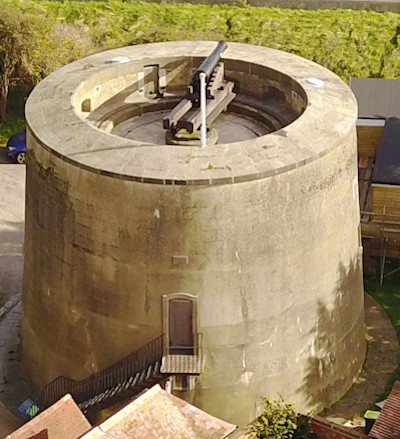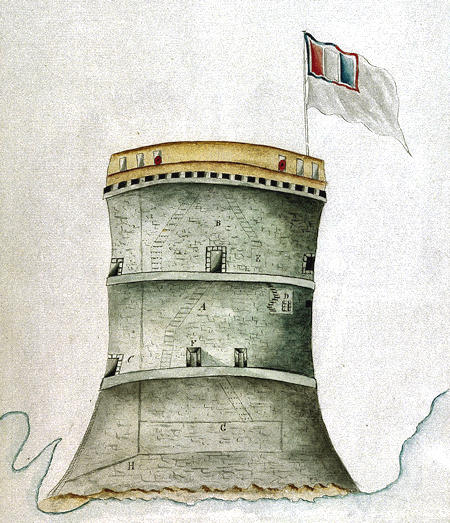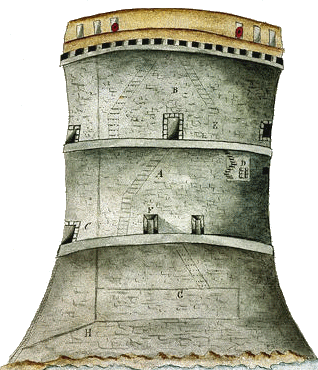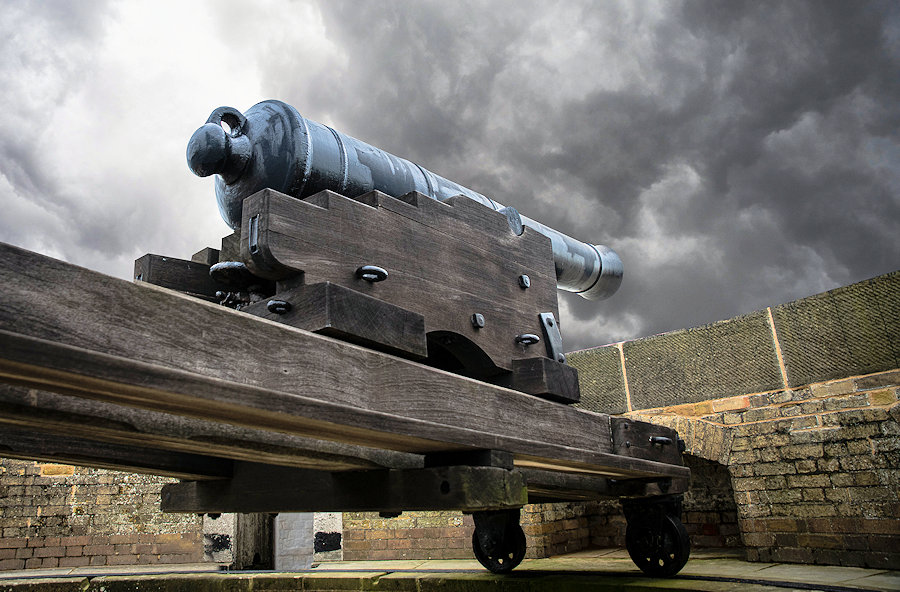Martello Towers
Martello Tower 24 in Dymchurch High Street is open to the public on Saturdays and Bank Holidays from Easter to the end of October - 2 pm to 4 pm - Admission Free, donations welcome.
Martello Towers, sometimes known simply as Martellos, are small defensive forts that were built across the British Empire (see map) during the 19th century, from the time of the French Revolutionary Wars onwards. Most were coastal forts.
Between 1796 and 1815, 194 towers were built; both in Britain and its dependencies, as part of a comprehensive defensive scheme and as a direct result of the British being at war with both France and the United States of America.
Between 1796 and 1815, 194 towers were built; both in Britain and its dependencies, as part of a comprehensive defensive scheme and as a direct result of the British being at war with both France and the United States of America.

Martello Tower Today
Martello Towers stand up to 40 feet (12 m) high, with a ground floor, first floor, and roof, housing a cannon.
They typically had a garrison of one officer and 15 to 24 men.
Their round structure and thick walls of solid masonry made them resistant to cannon fire.
Their height made them an ideal platform for a single heavy artillery piece, mounted on the flat roof and able to traverse and hence fire over a complete 360 degree circle.
Find out more
They typically had a garrison of one officer and 15 to 24 men.
Their round structure and thick walls of solid masonry made them resistant to cannon fire.
Their height made them an ideal platform for a single heavy artillery piece, mounted on the flat roof and able to traverse and hence fire over a complete 360 degree circle.
Find out more

The Original Martello Tower in Corsica
Martello Towers


 Martello Towers in
Martello Towers in
![]() Africa*
Africa*
![]() Asia*
Asia*
![]() Australasia
Australasia
![]() Canada*
Canada*
![]() Europe*
Europe*
![]() Ireland*
Ireland*
![]() North America*
North America*
![]() Other*
Other*
*page under construction
Map of Martello Towers Worldwide
In North America, the construction of MartelloTowers continued until 1873 when the Americans decided to abandon the building of towers at Key West prior to their completion.
In Europe, the construction of such towers had all but ended by 1815, with only five further towers being built, in Jersey, after this time. The practicality of the towers had diminished after 1815 because the perceived threat to British security posed by France had gone with the defeat of Napoleon at the Battle of Waterloo.
In Europe, the construction of such towers had all but ended by 1815, with only five further towers being built, in Jersey, after this time. The practicality of the towers had diminished after 1815 because the perceived threat to British security posed by France had gone with the defeat of Napoleon at the Battle of Waterloo.
By the 1850s developments in artillery meant that the towers were not strong enough to withstand an attack with the new rifled muzzle-loading cannon that was both more powerful and capable of being fired over large distances.
This swift obsolescence meant that many towers were promptly sold or adapted for other uses.

24 Pounder Cannon
This swift obsolescence meant that many towers were promptly sold or adapted for other uses.

24 Pounder Cannon
General Twiss's Original Design in c1800
“The interior circle of the tower has a diameter of 26 feet, and the area at the top is calculated to receive one 24 pounder Gun, and 2 Carronades of the same calibre, all mounted on traversing platforms, to fire over a high parapet, the crest of which is about 33 feet above the foundation. The ground floor to contain a powder magazine and cistern with room for provisions, fuel and other stores. The middle floor to lodge a garrison of one officer and 24 men, having an entrance placed 10 feet above the exterior ground. In this Project the centre Pillar is solid, and a stone staircase is contrived in the exterior wall which at that part is so encreased [sic] in thickness as to render it everywhere equally strong.”
“The interior circle of the tower has a diameter of 26 feet, and the area at the top is calculated to receive one 24 pounder Gun, and 2 Carronades of the same calibre, all mounted on traversing platforms, to fire over a high parapet, the crest of which is about 33 feet above the foundation. The ground floor to contain a powder magazine and cistern with room for provisions, fuel and other stores. The middle floor to lodge a garrison of one officer and 24 men, having an entrance placed 10 feet above the exterior ground. In this Project the centre Pillar is solid, and a stone staircase is contrived in the exterior wall which at that part is so encreased [sic] in thickness as to render it everywhere equally strong.”
Origins of Martello Towers
The resistance of the Torra di Mortella to the British in 1794 inspired Martello towers.
Martello towers were inspired by a round fortress, part of a larger Genoese defence system, at Mortella (Myrtle) Point in Corsica. The designer was Giovan Giacomo Paleari Fratino (el Fratin), and the tower was completed in 1565.The strength of such towers had been dramatically demonstrated to the British in February 1794, when a fleet under Lord Hood had been sent to capture Corsica. Crucial to the British attack was the capture of a stone watch-tower on Mortella Point. This tower was armed with one 6-pounder and two 18-pounder guns by the French and it successfully repulsed an attack by HMS Fortitude (74 guns) and HMS Juno (32 guns), both of which withdrew with serious damage and some sixty casualties. The army then built a four-gun battery some 150 yards from the tower and after two days of continuous bombardment forced the garrison to surrender.
The resistance of the Torra di Mortella to the British in 1794 inspired Martello towers.
Martello towers were inspired by a round fortress, part of a larger Genoese defence system, at Mortella (Myrtle) Point in Corsica. The designer was Giovan Giacomo Paleari Fratino (el Fratin), and the tower was completed in 1565.The strength of such towers had been dramatically demonstrated to the British in February 1794, when a fleet under Lord Hood had been sent to capture Corsica. Crucial to the British attack was the capture of a stone watch-tower on Mortella Point. This tower was armed with one 6-pounder and two 18-pounder guns by the French and it successfully repulsed an attack by HMS Fortitude (74 guns) and HMS Juno (32 guns), both of which withdrew with serious damage and some sixty casualties. The army then built a four-gun battery some 150 yards from the tower and after two days of continuous bombardment forced the garrison to surrender.
The first two descendants of the Mortella Point tower were built in 1796 in South Africa at Cape Col-
ony, a Dutch settlement seized by the British in 1795. New defences were built in preparation for an expected counter-attack and among these were two small round towers. This was hardly surprising as the man who led the expedition and became the first British governor of Cape Colony was George Elphinstone-now Vice-Admiral-who had been with the Mediterranean fleet off Corsica the previous year.
A little later in the same year that the towers at Cape Town and Simon's Town were built (1796) one was begun at Halifax, Nova Scotia. Although it was inspired by the much-discussed prototype in Corsica, it failed in several ways to measure up to it in construction. Between 1796 and the end of the war in 1815, 194 towers were built-all, with the exception of the early ones in Cape Colony and Halifax, to recognised standards as part of a comprehensive defence scheme, and as a direct result of Great Britain's war with France and her ally, the United States of America.
From 1815 the vogue for martello building in Eu-ope was over, with the exception of Jersey where five more towers were built. The construction of martellos was henceforth confined to North America, where defensive measures were kept alive by the political tension existing between Britain and the United States. Between 1820 and 1870 America built six martellos among her new coastal fortifications, while Canada added five to her existing number.
Martello building came to an end in 1873 with the abandonment of the Key West project in Florida; work was
stopped on the two unfinished towers known as martellos.
Source: 'Martello Towers' by Sheila Sutcliffe
ony, a Dutch settlement seized by the British in 1795. New defences were built in preparation for an expected counter-attack and among these were two small round towers. This was hardly surprising as the man who led the expedition and became the first British governor of Cape Colony was George Elphinstone-now Vice-Admiral-who had been with the Mediterranean fleet off Corsica the previous year.
A little later in the same year that the towers at Cape Town and Simon's Town were built (1796) one was begun at Halifax, Nova Scotia. Although it was inspired by the much-discussed prototype in Corsica, it failed in several ways to measure up to it in construction. Between 1796 and the end of the war in 1815, 194 towers were built-all, with the exception of the early ones in Cape Colony and Halifax, to recognised standards as part of a comprehensive defence scheme, and as a direct result of Great Britain's war with France and her ally, the United States of America.
From 1815 the vogue for martello building in Eu-ope was over, with the exception of Jersey where five more towers were built. The construction of martellos was henceforth confined to North America, where defensive measures were kept alive by the political tension existing between Britain and the United States. Between 1820 and 1870 America built six martellos among her new coastal fortifications, while Canada added five to her existing number.
Martello building came to an end in 1873 with the abandonment of the Key West project in Florida; work was
stopped on the two unfinished towers known as martellos.
Source: 'Martello Towers' by Sheila Sutcliffe
Mortella and Martello?
Why are the towers known as Martello and not Mortella? There is no doubt that Martello Towers are based on the Mortella Tower at San Fiorenzo Bay in Corsica, so why the change to Martello?
Why are the towers known as Martello and not Mortella? There is no doubt that Martello Towers are based on the Mortella Tower at San Fiorenzo Bay in Corsica, so why the change to Martello?
- Firstly, that the British simply got the name wrong, either mispronouncing or misspelling, or a combination of both, "Mortella" as "Martello"?
There is strong support for this explanation as there is on record a letter sent by Lord Hood, Commander in Chief of the Fleet in the Mediterranean, from Victory, Martello-Bay, August 5, 1794, and included the paragraph
Upon my junction with Vice- Admiral Hotham off this port, on the 9th, I detached Captain Nelson, in the Agamemnon, to Bastia, with orders to embark the troops, and proceed with them to Martello Bay, where Lieutenant-General Stuart embarked on the 15th; and expressing a wish to proceed to the attack of Calvi immediately, Captain Nelson complied with it, and on the 19th all the troops were landed, under the direction of Captain Cooke, in a small cove, about three miles from Calvi. - It has been suggested that the name Martello, instead of Mortella, is of Italian origin. There were similar towers in Italy called Tori Di Martello. Martello is Italian for Hammer. Each tower contained an alarm bell which was struck with a hammer.
- Or was it based on 'Myrtello Point', which was the geographical name of the headland where the tower stood; the headland was covered in the wildflower Myrtle?
What makes a Gun Fort a Martello Tower?
• used for coastal defence
• very thick strong walls and long-lasting
• flat roof with a parapet
• high-level entrance door
• of circular/oval shape
• the walls have a distinct slope or batter from the base of the tower to its top
• large cannon able to traverse through 360°
• a large, strong central pillar to support the cannon and act as a pivot for its traversing carriage
• small garrison
Not all of the c200 Martello Towers built had all these characteristics but most had many of them.
Sources: 'Martello Towers' by Sheila Sutcliffe; 'Dymchurch Martello Tower English Heritage' by J G Goad
• used for coastal defence
• very thick strong walls and long-lasting
• flat roof with a parapet
• high-level entrance door
• of circular/oval shape
• the walls have a distinct slope or batter from the base of the tower to its top
• large cannon able to traverse through 360°
• a large, strong central pillar to support the cannon and act as a pivot for its traversing carriage
• small garrison
Not all of the c200 Martello Towers built had all these characteristics but most had many of them.
Sources: 'Martello Towers' by Sheila Sutcliffe; 'Dymchurch Martello Tower English Heritage' by J G Goad
Sir Walter Scott wrote about Martello Towers in his novel Peveril of the Peak:
From this feudal Baron, who chose his nest upon the principles on which an eagle selects her eyry, and built it in such a fashion as if he had intended it, as an Irishman said of the Martello Towers, for the sole purpose of puzzling posterity, there was, ...
From this feudal Baron, who chose his nest upon the principles on which an eagle selects her eyry, and built it in such a fashion as if he had intended it, as an Irishman said of the Martello Towers, for the sole purpose of puzzling posterity, there was, ...





